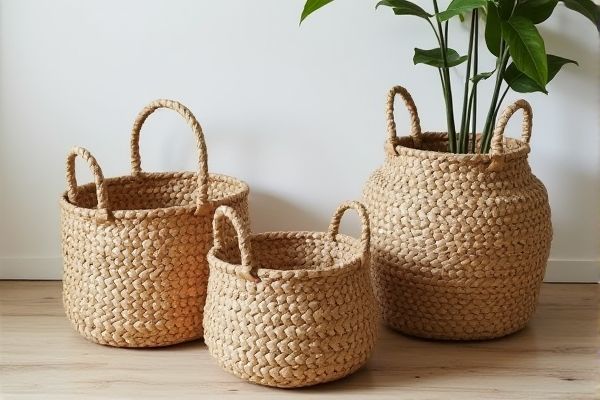
Natural fiber baskets offer eco-friendly, biodegradable options with unique textures and traditional craftsmanship, while synthetic baskets provide enhanced durability, water resistance, and often lower costs. Explore the rest of the article to discover which basket type best suits Your needs and lifestyle.
Table of Comparison
| Feature | Natural Fiber Baskets | Synthetic Baskets |
|---|---|---|
| Material | Made from organic sources like jute, rattan, bamboo | Made from plastic, nylon, polyester |
| Durability | Moderate; prone to wear and moisture damage | High; resistant to moisture, mold, and wear |
| Eco-Friendliness | Biodegradable and renewable | Non-biodegradable; environmental impact |
| Strength | Suitable for light to medium loads | Suitable for heavy loads |
| Appearance | Natural, rustic, aesthetic appeal | Available in various colors and designs |
| Cost | Generally affordable; depends on fiber type | Varies; often low-cost mass production |
| Maintenance | Requires careful handling; avoid prolonged moisture | Easy to clean and maintain |
| Use Cases | Home decor, gifting, light storage | Industrial, outdoor storage, heavy-duty use |
Introduction to Natural Fiber and Synthetic Baskets
Natural fiber baskets are crafted from renewable materials like rattan, seagrass, and jute, offering eco-friendly durability and a rustic aesthetic. Synthetic baskets, made from plastic or resin, provide enhanced water resistance and long-lasting strength, ideal for heavy-duty or outdoor use. Your choice depends on preferences for sustainability, texture, and functional longevity.
Types of Natural Fiber Baskets
Natural fiber baskets are crafted from materials such as seagrass, jute, rattan, and bamboo, each offering unique textures and durability suited for various uses. Seagrass baskets provide excellent water resistance, making them ideal for humid environments, while rattan and bamboo offer sturdy construction for heavier storage needs. Jute baskets are lightweight and eco-friendly, commonly used for decorative purposes or light storage.
Common Materials in Synthetic Baskets
Synthetic baskets commonly utilize materials such as polyethylene, polypropylene, and nylon, which offer durability, water resistance, and flexibility. These materials are engineered to withstand various environmental conditions, making synthetic baskets ideal for outdoor use and heavy-duty applications. Unlike natural fibers, synthetic materials provide consistent texture and color retention, enhancing their longevity and aesthetic appeal.
Durability: Natural vs Synthetic Baskets
Natural fiber baskets, made from materials like jute, seagrass, or rattan, offer eco-friendly appeal but may degrade faster due to moisture and wear. Synthetic baskets, typically crafted from plastic or resin, provide superior durability, resisting water damage, UV exposure, and daily abrasion much better than their natural counterparts. Choosing synthetic baskets ensures longer-lasting use for your storage needs, especially in environments prone to humidity or heavy handling.
Environmental Impact and Sustainability
Natural fiber baskets, made from materials like jute, seagrass, and rattan, offer a biodegradable and renewable option that significantly reduces environmental pollution compared to synthetic baskets composed of non-biodegradable plastics. Synthetic baskets rely on petroleum-based resources, contributing to greenhouse gas emissions and microplastic pollution, whereas natural fiber baskets promote sustainable harvesting and minimal chemical processing. Choosing natural fiber baskets supports your commitment to eco-friendly living by lowering your carbon footprint and enhancing sustainability.
Aesthetic Appeal and Design Differences
Natural fiber baskets showcase organic textures and earthy tones, offering a rustic, artisanal aesthetic that enhances eco-friendly and bohemian interiors. In contrast, synthetic baskets provide a wide range of vibrant colors and uniform patterns, allowing for sleek, modern designs with high durability and resistance to wear. The choice between these materials influences both visual impact and functional style, catering to diverse decorative preferences.
Maintenance and Cleaning Requirements
Natural fiber baskets require gentle cleaning with a soft brush or damp cloth to avoid damage, and they should be kept dry to prevent mold and mildew. Synthetic baskets, on the other hand, are typically more durable and easier to clean, often suitable for wiping with mild soap and water without risk of deterioration. Your choice depends on whether you prioritize eco-friendly materials with delicate care or low-maintenance, long-lasting usability.
Cost Comparison: Natural vs Synthetic
Natural fiber baskets typically cost more than synthetic baskets due to the labor-intensive harvesting and processing of materials like jute, seagrass, or rattan. Synthetic baskets, often made from plastic or resin, are generally cheaper to produce and purchase because of mass manufacturing and lower material costs. Your choice between the two depends on balancing budget constraints with preferences for eco-friendly, durable, or aesthetic qualities.
Best Uses and Practical Applications
Natural fiber baskets excel in eco-friendly storage, ideal for organizing laundry, toys, and household items with breathable, biodegradable materials like jute, seagrass, or rattan. Synthetic baskets offer durability and water resistance, making them perfect for outdoor use, wet environments, and heavy-duty storage needs, using plastics like polypropylene or nylon. Your choice depends on whether you prioritize sustainability and aesthetics or sturdiness and low maintenance.
Conclusion: Making the Right Choice
Natural fiber baskets offer eco-friendly, biodegradable options with a rustic aesthetic, while synthetic baskets provide durability, resistance to moisture, and diverse design choices. Your decision should consider sustainability goals, intended use, and maintenance preferences to ensure the basket aligns with your lifestyle. Selecting the right basket balances environmental impact and functionality for optimal satisfaction.
 homyna.com
homyna.com